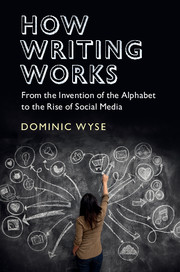Book contents
- How Writing Works
- How Writing Works
- Copyright page
- Dedication
- Contents
- Figures and Tables
- Acknowledgements
- Introduction
- 1 Thinking about Writing and Language
- 2 A History of Writing
- 3 Writing Guidance
- 4 Expert Writers
- 5 Creativity and Writing
- 6 Novice Writers and Education
- 7 The Process of Writing
- Bibliography
- Index
- References
Bibliography
Published online by Cambridge University Press: 12 December 2017
- How Writing Works
- How Writing Works
- Copyright page
- Dedication
- Contents
- Figures and Tables
- Acknowledgements
- Introduction
- 1 Thinking about Writing and Language
- 2 A History of Writing
- 3 Writing Guidance
- 4 Expert Writers
- 5 Creativity and Writing
- 6 Novice Writers and Education
- 7 The Process of Writing
- Bibliography
- Index
- References
- Type
- Chapter
- Information
- How Writing WorksFrom the Invention of the Alphabet to the Rise of Social Media, pp. 224 - 231Publisher: Cambridge University PressPrint publication year: 2017



